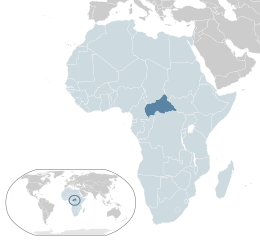Commons:Copyright rules by territory/Central African Republic/gu
|
Copyright rules: the Central African Republic Shortcut: COM:Central African Republic | |
 | |
 | |
| Durations | |
|---|---|
| Standard | જીવન + ૫૦ વર્ષો |
| ફોટોગ્રાફ | સર્જન + ૨૦ વર્ષો |
| Anonymous | સર્જન/પ્રકાશન + ૫૦ વર્ષો |
| Audiovisual | સર્જન/પ્રકાશન + ૫૦ વર્ષો |
| Applied art | સર્જન + ૨૦ વર્ષો |
| અન્ય | |
| Freedom of panorama | For films, radio and television broadcasts |
| Common licence tags | {{PD-Central African Republic}} |
| સંધિઓ | |
| Berne convention | ૩ સપ્ટેમ્બર ૧૯૭૭ |
| Bangui Agreement | ૮ ફેબ્રુઆરી ૧૯૮૨ |
| WTO member | ૩૧ મે ૧૯૯૫ |
| URAA restoration date* | ૧ જાન્યુઆરી ૧૯૯૬ |
| *A work is usually protected in the US if it is a type of work copyrightable in the US, published after 31 December ૧૯૨૮ and protected in the country of origin on the URAA date. | |
This page provides an overview of copyright rules of the Central African Republic (CAR) relevant to uploading works into Wikimedia Commons. Note that any work originating in the Central African Republic must be in the public domain, or available under a free license, in both the Central African Republic and the United States before it can be uploaded to Wikimedia Commons. If there is any doubt about the copyright status of a work from the Central African Republic, refer to the relevant laws for clarification.
Governing laws
France created the Ubangi-Shari territory in 1894 and ruled it as a colony until 1960, when it became fully independent as the Central African Republic.
The Central African Republic has been a member of the Berne Convention since 3 September 1977, the Bangui Agreement since 8 February 1982 and the World Trade Organization since 31 May 1995.
As of 2018 the World Intellectual Property Organization (WIPO), an agency of the United Nations, listed Ordinance No. 85.002 of January 5, 1985, on Copyrights as the main copyright law issued by the Executive of the Central African Republic.[1] WIPO holds the text of this law in their WIPO Lex database.
સામાન્ય નિયમો
Under Ordinance No. 85.002 of 5 January 1985,
- The author's rights last for their lifetime and for 50 years counting from the end of their year of death, or in the case of collaborative works from the end of the year of death of the last surviving author.[85.002 Article 40]
- For cinematographic, radiophonic and audiovisual works, protection lasts for 50 years from when it was lawfully made available to the public, or for 50 years from creation if it was not published within 50 years.[85.002 Article 40 (1)]
- Works owned by a legal entity, anonymous and pseudonymous works and posthumous works are protected for 50 years from being lawfully made available to the public.[85.002 Article 41]
- Photographs and works of applied art are protected for 20 years from creation.[85.002 Article 40 (2)]
- Laws, official texts of administrative or judicial nature, or the official translations thereof are not subject to copyright.[85.002 Article 10]
Folklore: not free
આ પણ જુઓ : Commons:Paying public domain
Folklore belongs to the national heritage. It includes literary and artistic works created by national communities and transmitted from generation to generation. Public representation, performance or direct or indirect recording of folklore for profit requires authorization from the office responsible for copyright and payment of a royalty. The proceeds will be used to support cultural and social activities to the benefit of the authors.[85.002 Article 9]
Not protected
આ પણ જુઓ : Commons:Unprotected works
Article 10 of the 1985 law states that protection does not apply to laws, judicial or administrative decisions or official translations of these texts, or to news of the day published, broadcast by radio or television, or communicated in public.[85.002 Article 10]
Currency
આ પણ જુઓ : Commons:Currency
![]() . Bank of Central African States, which issues Central African CFA franc used in Central African Republic, is based in Cameroon. Article 3c of the main IP law of Cameroon, the 2000 Copyright law, explicitly excludes banknotes and coins from copyright protection.
. Bank of Central African States, which issues Central African CFA franc used in Central African Republic, is based in Cameroon. Article 3c of the main IP law of Cameroon, the 2000 Copyright law, explicitly excludes banknotes and coins from copyright protection.
Please use {{PD-CA-CFA-franc}} for Central African CFA franc images.
See also: COM:CUR Cameroon
Freedom of panorama
આ પણ જુઓ : Commons:Freedom of panorama
![]() . For photographs, drawings, paintings etc. of protected works of art or architecture.
. For photographs, drawings, paintings etc. of protected works of art or architecture.![]() for films, radio and television broadcasts of protected works if permanently in a public place or included only incidentally.
for films, radio and television broadcasts of protected works if permanently in a public place or included only incidentally.
Chapitre II: Limitation permanente of the 1985 law includes the following:
- Article 11 allows copying, performance or broadcasting of protected works for non-commercial private or family use, or for scholarly or religious use.
- Article 14 allows reproduction and communication to the public of literary, artistic or scientific works when reporting a news event by photography or film to the extent necessary to convey the information.
- Article 15 allows reproduction for cinematography, radio or television broadcasting of works of art or architecture if placed permanently in a public place or if its inclusion is accessory or incidental to the main subject.